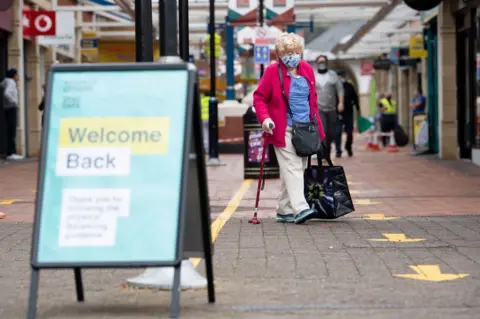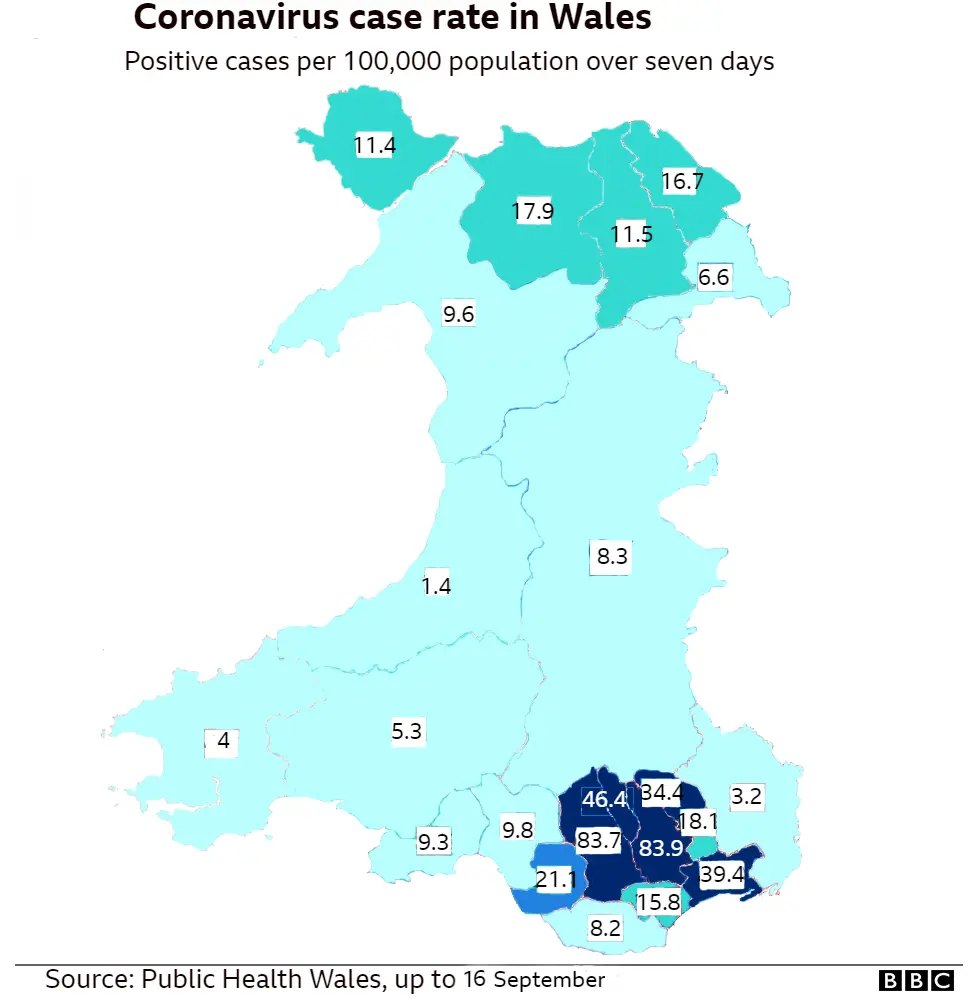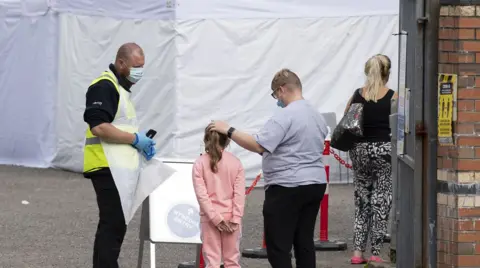Coronavirus: After Rhondda Cynon Taf, where might the next lockdown be?
 Getty Images
Getty ImagesSix weeks ago, there were fears of a local lockdown in Wrexham.
The local hospital was dealing with 63 coronavirus cases, the area had easily the highest infection rate in Wales and hundreds went to local mobile testing centres.
Now, the area has one of the lowest infection rates in Wales - and it currently ranks 185th in the UK's list of hardest hit areas, as analysed by the BBC.
But for two weeks running in August, Wrexham had more deaths involving Covid-19 than anywhere else in the UK. The consequence of that earlier spike was showing itself.
That is why public health officials are closely watching any part of Wales which shows signs of a jump in cases.

What are we looking for?
Daily blips can happen, so health officials look at the case rate over the last week - the proportion of positive tests per 100,000 population.
They also look at the positivity rate - how many people tested actually turn out to have Covid-19 - and with more than 9,000 being tested a day now, when that gets above 4% it becomes concerning.
In Rhondda Cynon Taf (RCT), this rate is currently 5.7% - the highest proportion in Wales and double the national average.
Health officials are also looking closely at where people with infections are living. Is it confined to their circle of family and friends or in the wider community?
With the easing of lockdown, pockets and clusters of cases were expected. The Welsh Government's track and trace system so far has a very high success rate, so knowing exactly where the infections are, and keeping a lid on the problem when it occurs, is key.
Officials can access micro-data, so they can tell which neighbourhoods are affected.
When they start to see a lot of cases that they can't track back to a source case then that's a strong indicator that there's community transmission.
It means efforts to specifically isolate groups or individuals have failed to contain the virus.
When that occurs it makes the prospect of a local lockdown far more likely.
This is what happened in RCT.
 Getty Images
Getty ImagesWhen cases move up too fast - and too high - local areas are watched very carefully.
A few weeks ago, Cardiff showed an upsurge in cases. This showed up in mainly younger people and was blamed on socialising and people not social distancing. It was complicated by infected holidaymakers flying back from Greece.
Cardiff is now steady at 15.8 cases per 100,000 and an example of how a worrying rise in cases does not mean lockdown is inevitable.
At the weekend, a surge in cases in Newport was blamed on parties around the recent bank holiday and its case rate is still of concern, alongside neighbouring Caerphilly - where the first lockdown was imposed more than a week ago.
Caerphilly still has the highest case rate in Wales but RCT has almost caught it up.
Both rank in the top 20 hardest hit areas in the UK - although this is dominated by towns in Greater Manchester and Lancashire.
In recent days, there was a rise in cases in Powys and Conwy, and most recently in Bridgend - which currently has more than 20 cases per 100,000 - and Blaenau Gwent, on 34.4.
Merthyr Tydfil has the smallest population of any Welsh council area, so a small jump in infections can push up the case rate. But over the course of the pandemic it has the highest cumulative case rate, thanks mainly to an outbreak associated with workers from a meat plant. In the last week it has risen 46.4 cases per 100,000 - the fourth highest in Wales.
More people are starting to see their GP with Covid-19 symptoms after a lull.
But it is hospital admissions which are being watched keenly.
Cwm Taf Morgannwg - which covers RCT and Bridgend - had 14 covid-related admissions on Tuesday, the highest number since mid-June.
The previous week had seen the highest level of admissions with coronavirus since the start of August.
Despite a fall on the previous week, more than half of all Covid-19 hospital admissions in Wales are still in Aneurin Bevan, which covers Caerphilly and Newport, and Cwm Taf Morgannwg.
Dr Robin Howe, of Public Health Wales, told BBC Radio Wales he feared the level of infections in these areas meant a "high risk" of a rise in hospital admissions and this in turn could lead to a rise in deaths.
"We are seeing older age groups now being infected and there is obviously a sad risk that we may be seeing deaths.
"We would expect that hospital admissions would be increasing around about now and we are perhaps starting to see that in Cwm Taf Morgannwg health board and there may be deaths in the coming days."
